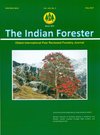Polyembryony in Syzygium cumini (L.) Skeels
DOI:
https://doi.org/10.36808/if/2017/v143i5/114982Abstract
No Abstract.References
Kumar A., Gupta B.B. and singh U. (1991). Polyembryony in Acacia nilotica. Indian Forester, 117:124-125.
Ayyanar M. and Babu P.S. (2012). Syzygium cumini (L.) Skeels: A review of its phytochemical constituents and traditional uses. Asian Pacific Journal of Tropical Biomedicine, 240-246.
Chaudhary B. and Mukhopadhyay K. (2012). Syzygium cumini (L.) Skeels: a potential source of nutraceuticals. Inter. J. Pharmacy and Biological Sciences, 2(1):46-53.
Dabral S.L. (1977). Polyembryony in Teak. Indian Forester, 103(10): 694.
Dobriyal N.D. and Bagchi S.K. (1990). Polyembryony in Acacia nilotica Linn. Indian J. Forestry, 13:360-361.
Gunaga R.P., Ganiger R.V., Smita D.A., Shinde P., Rane A.D. (2012). Poly-embryony in Calophyllum inophyllum L. Indian Forester, 138:305-306.
Gupta P., Shiranna K.R., Ram H.Y.M. and Gupta P. (1996). Apomixis and polyembryony in the guggul plant, Commiphora wightii. Annals of Botany, 78:67-72.
Jose P.A, Mohanan N. and Hussain A. (2009). Occurrence of twin seedlings in Humboldtia vahliana Wight and Syzygium mundagom (Bourd.) Chithra – two endemic trees of Southern Western Ghats. Indian Forester, 135:290-292.
Kumaran K., Srimathi P., Jerlin R. and Palani M. (1999). Polyembroyony in Calophyllum inophyllum L. J. Non Timber Forest Products, 6(1and2):83-84.
Maheswari P. and Sacher R.C. (1963). Polyembryony. In Recent advances in the embryology of Angiosperms (P Maheswari, ed.). International Society of Plant Morphologists,New Delhi, p.265-296.
Namasivayam R., Ramachandrani B. and Deecaraman M. (2008) Effect of aqueous extract of Syzygium cumini pulp on antioxidant defense system in streptozotocin induced diabetic rats. Inter. J. Post Harvest Technology, 7:137-145.
Sagrawat H., Mann A.and Kharya M. (2006).Pharmacological potential of Eugenia jambolana: A Review. Pharma co-genesis Magazice, 2:96-104.
Shrivas R.K. and Bajpai S.P. (1990). A note on twin seedling in Pterocarpus marsupiumRoxb. Indian Forester, 116(3):249.
Singh A.N. and Thakur A. (2004). Polyembryony in Dipterocarpus retusus. J. Tropical Forest Science, 16(4):475-476.
Singh B.G., Mahadevan N.P., Shanthii K., Geetha S. and Manimuthu L. (1995). Multiple seedling development in Neem (Azardirachta indica). Indian Forester, 121:1049-1052.
Sivasubramaniam K. and Selvarani K. (2012). Viability and vigor of jamun (Syzygium cumini) seeds. Brazilian Journal of Botany, 35(4):397-400.
Downloads
Downloads
Published
How to Cite
Issue
Section
License
Unless otherwise stated, copyright or similar rights in all materials presented on the site, including graphical images, are owned by Indian Forester.





